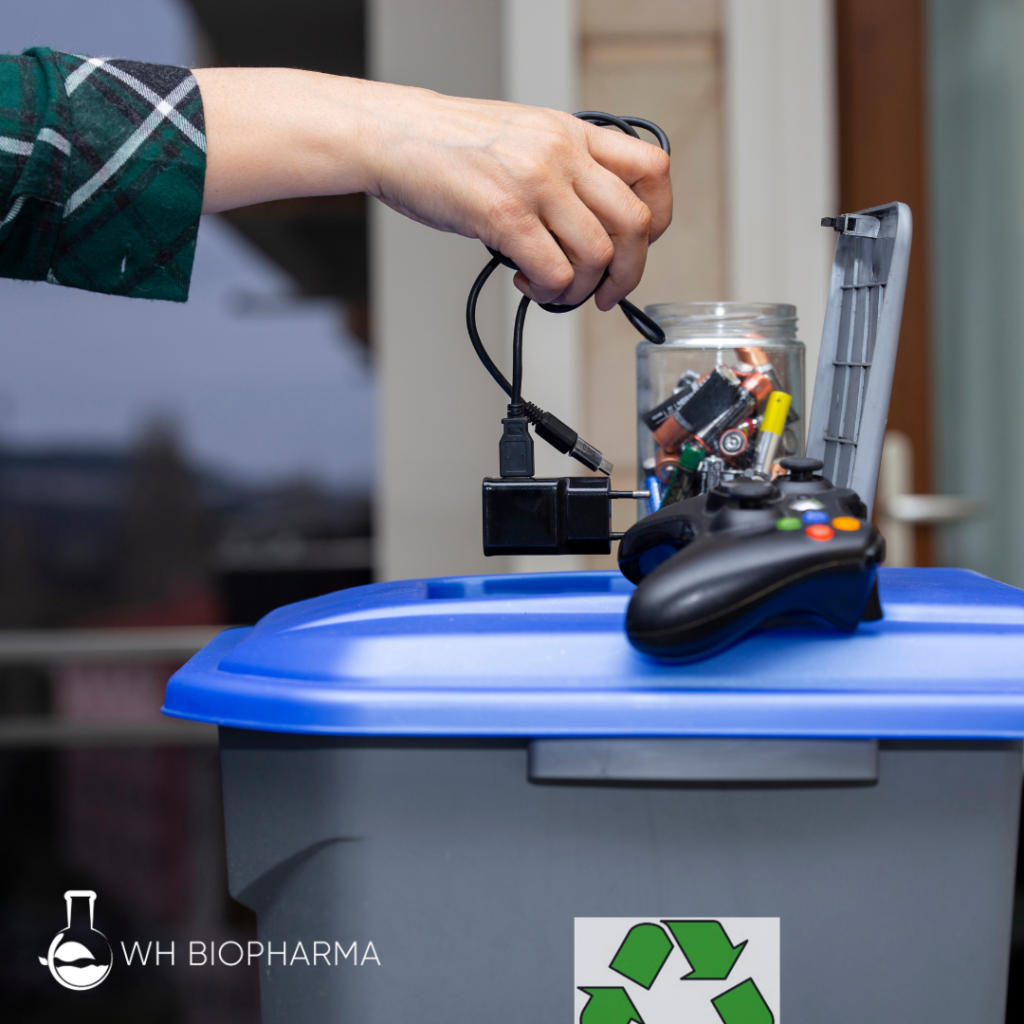In the rapidly evolving landscape of electronics manufacturing, the traditional linear model of “take, make, dispose” is proving unsustainable and environmentally damaging. The advent of the circular economy paradigm in the electronics industry marks a transformative shift towards sustainable practices, particularly in addressing the challenges posed by electronic waste (e-waste).
This article explores the principles of circular economy in electronics manufacturing, highlighting the significance of e-waste recycling in circular models and its potential to revolutionize the way electronic devices are produced, used, and disposed of.
Understanding the Circular Economy in Electronics
The circular economy concept in electronics revolves around breaking away from the linear model, where electronic products are created, used, and then discarded, often leading to environmental degradation and resource depletion.
Instead, a circular approach focuses on maximizing resource efficiency, minimizing waste, and promoting the reuse and recycling of materials to create a closed-loop system.
Business Models in Circular Electronics
Circular business models in the electronics sector are designed to extend the lifespan of electronic devices and their components.
Instead of focusing solely on selling products, companies are exploring innovative approaches such as product-as-a-service, leasing, and take-back programs. These models emphasize durability, repairability, and end-of-life considerations, aligning with the principles of the circular economy.
Recycling Processes and Maximizing Resource Efficiency

At the heart of the circular economy in electronics is the efficient and sustainable management of electronic waste. Recycling processes play a pivotal role in reclaiming valuable materials from discarded electronic devices, mitigating the environmental impact of e-waste.
Maximizing resource efficiency involves extracting and reusing materials such renewable energy such as metals, plastics, and rare earth metals, reducing the reliance on virgin raw materials.
Global E-Waste Challenges and Circular Solutions
The electronics industry faces significant challenges related to the global generation of e-waste. As electronic products become more ubiquitous, the need for sustainable solutions intensifies.
Circular economy models provide a strategic framework and business strategy for addressing the challenges associated with hazardous substances, health risks, and the environmental impact of improper e-waste disposal on a global scale.
Circular Electronics Initiative: A Collaborative Approach
The Circular Electronics Initiative, championed by organizations like the Ellen MacArthur Foundation, encourages collaboration among stakeholders in the electronics industry. This initiative emphasizes the importance of circular practices, resource efficiency, and environmentally sound management of e-waste.
By fostering partnerships and sharing best practices, the initiative aims to drive systemic change across the electronics sector.
Valuable Materials in E-Waste: Turning Waste into Resources
Electronic devices contain a myriad of valuable materials, including precious metals, rare earth metals, and other recyclable components.
Circular strategies aim to recover these materials through efficient recycling processes, reducing the need for extracting new resources and minimizing the environmental impact associated with mining and refining new materials.
The Role of Supply Chains in Circular Electronics
Circular strategies in electronics necessitate a rethinking of supply chain dynamics. From the design phase to the end of life, incorporating circular principles involves selecting durable materials, minimizing waste in production, and establishing efficient take-back programs.
Sustainable choices of resources in the supply chain contribute to the overall success of businesses with circular business models.
Circular Product Design: A Pillar of Sustainable Electronics
Circular product design is a cornerstone of sustainable electronics manufacturing. It involves creating products that are easy to repair, upgrade, and recycle.
Designing for circularity enables the incorporation of recycled content, prolongs the lifespan of electronic devices, and reduces the environmental footprint associated with their production and disposal.
Environmental Degradation and the Need for Circular Practices
The linear model of electronics manufacturing contributes significantly to environmental degradation, including pollution, resource depletion, and the release of hazardous substances.
Circular practices offer a viable solution by promoting responsible product design, efficient recycling processes, reuse and the reduction of electronic waste, thereby mitigating the negative environmental impacts of the industry.
The Economic Benefits of Circular Electronics
Embracing circular business models in the electronics sector not only aligns with environmental sustainability but also presents economic benefits.
Recycling processes generate new economic opportunities by using waste materials creating jobs for businesses in the recycling industry, reducing the demand for virgin raw materials, and contributing to a more resilient and resource-efficient economy.
Challenges in Implementing Circular Electronics
While the circular economy offers a promising framework for addressing the challenges of e-waste, its implementation in the electronics industry is not without hurdles.
Manufacturers face significant challenges in transitioning from a linear model to circular strategies, including initial exploration costs, consumer awareness, and the need for industry-wide collaboration.
Examples of Circular Electronics Success Stories
Several companies within the electronics industry have successfully implemented circular business models, demonstrating the feasibility and benefits of such approaches.
Examples include companies that have incorporated recycled materials into their products, initiated take-back programs for consumers, and embraced product-as-a-service models. These success stories serve as inspiration for others looking to adopt circular practices.
The Future of Circular Electronics

As the electronics industry grapples with the environmental and social consequences of its linear model, the circular economy offers a path towards a more sustainable and responsible future.
With ongoing advancements in technology, increased consumer awareness of circular products, and a growing emphasis on corporate responsibility, the circular economy is poised to become the standard for electronics manufacturing.
Technological Advancements in Recycling Processes
The future of circular electronics will witness significant strides in recycling technologies. Advanced processes such as automated repair and disassembly, robotic sorting, and innovative extraction methods will enhance the efficiency of reclaiming valuable materials from electronic devices. These technological advancements will not only reduce the environmental impact of e-waste but also contribute to the circular economy by closing the loop on resource utilization.
Designing for Circularity Becomes Standard Practice
Circular product design, a fundamental aspect of sustainable electronics, will become a standard practice in the industry. Manufacturers will increasingly prioritize designing products that are modular, repairable, and upgradable. The shift towards a ‘Design for Circularity’ approach will not only extend the lifespan of electronic devices but also facilitate easier recycling and reduce the overall environmental footprint of electronic products.
Proliferation of Circular Business Models
Circular business models, such as product-as-a-service and leasing arrangements, will gain prominence in the electronics industry. Companies will move beyond the traditional linear model of selling products and embrace innovative approaches that prioritize durability, repairability, and end-of-life considerations. These models will not only align with the principles and benefits of the circular economy but also cater to evolving consumer preferences for sustainable and ethical practices.
Global Collaboration and Standardization
The future of circular electronics will be characterized by increased global collaboration and standardization efforts. Stakeholders, including governments, manufacturers, and non-governmental organizations, will work together to establish international standards for e-waste management, recycling processes, and circular business practices. This collaborative approach will streamline operations, enhance efficiency, and create a more cohesive global framework for circular electronics.
E-Waste Tracking and Traceability
Advancements in technology will enable comprehensive tracking and traceability of e-waste throughout its lifecycle. Blockchain technology, in particular, holds the potential to create transparent and secure systems for monitoring the movement of electronic products, ensuring responsible disposal, and tracking the incorporation of recycled materials back into new electronics products made. E-waste traceability will become a cornerstone of accountable and sustainable electronics manufacturing.
Consumer Awareness and Demand for Sustainable Electronics
Increasing consumer awareness about the environmental impact of electronic products will drive a shift in consumer behavior. Consumers will actively seek out sustainable and circular electronics, prompting manufacturers to respond to the demand from consumers for products with longer lifespans, easy repairability, and clear end-of-life solutions. This shift in consumer preferences will act as a catalyst for the widespread adoption of circular practices in the electronics industry.
Government Incentives and Legislation
Governments worldwide will play a pivotal role in shaping the future of the circular business model in electronics through the introduction of incentives and legislation. Policies encouraging manufacturers to adopt circular business models, offering tax breaks for sustainable practices, and imposing stringent regulations on e-waste management will drive the industry towards a more circular and responsible future.
Innovation in Material Science
Advancements in material science will contribute to the development of eco-friendly and sustainable materials for electronic devices. Researchers will explore alternatives to traditional materials, reducing the reliance on rare earth metals and hazardous substances. This innovation in material science will not only enhance the recyclability of electronic products but also pave the way for the creation of more environmentally friendly devices.
Extended Producer Responsibility (EPR) Implementation
The implementation of Extended Producer Responsibility (EPR) programs will become more widespread. Manufacturers will be held accountable for the entire lifecycle of their products, from production to disposal. EPR initiatives will drive companies to design and manufacture products with end-of-life considerations in mind, promote take-back programs, and invest in responsible e-waste management.
Integration of Circular Economy Principles Across Industries
Circular economy principles will transcend the boundaries of the electronics industry, influencing practices across various sectors. The success of the circular economy business models in electronics will inspire other industries to adopt similar approaches, creating a domino effect that fosters a more sustainable and regenerative global economy.
The transition to a circular economy in electronics manufacturing represents a paradigm shift that holds the promise of a more sustainable and resilient industry.
By prioritizing the efficient use of resources, responsible product design, and the recycling of valuable materials, the electronics sector can contribute to minimizing waste, reducing environmental impact, and fostering a more circular and regenerative economy.
As the industry continues to evolve, embracing circular business models becomes not only an ethical imperative but also a strategic necessity for long-term success in a resource-constrained world.





